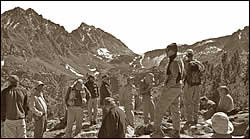Field Forum
Report
Rethinking the Assembly and Evolution of Plutons:
Field Tests and Perspectives
7-13 October 2005
Sierra Nevada and White-Inyo Mountains, California USA
- Conveners
- John M. Bartley, Department of Geology and Geophysics, University of Utah, Salt Lake City, Utah 84112-0111, USA, +1-801-585-1670,
- Drew S. Coleman, Department of Geological Sciences, University of North Carolina, Chapel Hill, North Carolina 27599-3315, USA, +1-919-962-0705,
- Allen F. Glazner, Department of Geological Sciences, University of North Carolina, Chapel Hill, North Carolina 27599-3315, USA, +1-919-962-0689,
- Aaron Yoshinobu, Department of Geosciences, Texas Tech University, Lubbock, Texas, 79409-1053, USA,
- Richard D. Law, Department of Geosciences, Virginia Tech., Blacksburg, Virginia 24061, USA,
On 7-13 October 2005, 40 geologists gathered to examine field evidence concerning the assembly of plutons and to discuss the idea that plutons may be incrementally constructed over millions of years. Participants included specialists in plutonic, volcanic, and structural geology; perhaps the most significant benefit of the meeting was the interaction among these groups.
The forum comprised five field days, an evening poster session, and a wrap-up session. The first two days were spent in Yosemite National Park, examining the 103 Ma Yosemite Valley intrusive suite and the 95-85 Ma Tuolumne Intrusive Suite. Day 1 focused on the role of mafic magmatism in the evolution of the suites, contact relations between the two suites, and reasons for the marked differences between them.
Day 2 centered on the contact of the Tuolumne Intrusive Suite and the anatomy of the Half Dome Granodiorite, which U-Pb zircon data indicate grew over 3-4 m.y. One focus was wall-rock inclusions in the outermost Tuolumne Intrusive Suite: do they reflect stoping or in situ isolation by dike intrusion? Related questions included the significance of gradational contacts between units that yield distinct U-Pb zircon ages, and the origin of modal layering. We examined km-scale lithologic cycles in Half Dome that may reflect incremental assembly, as well as K-feldspar crystal-size distributions passing from the equigranular Half Dome to its porphyritic phase to the megacrystic Cathedral Peak, and considered implications for timing and mechanisms of phenocryst growth.
The next two days were spent in the eastern Sierra Nevada. On Day 3, we examined the Treasure Lakes mass of the Lamarck Granodiorite, a steeply tabular pluton emplaced into a ductile shear zone late during its movement history. Discussion focused on the role of the shear zone during intrusion, the presence of melt in the granite during deformation, and, again, the origin of tabular wall-rock inclusions.
Day 4 began with views from Owens Valley of intrusive relationships exposed high in the Sierras: (1) the Split Mountain wall-rock screen forms the roof of the leucogranite of Red Mountain Creek and the floor of the Tinemaha Granodiorite, and (2) the Goodale intrusive complex comprises a large layered mafic complex overlain by and commingled with granite. Discussion centered on pluton floors and on formation of mafic sheeted complexes as floors of magma chambers versus injection of sills. We then examined mafic-felsic interactions in the Jurassic Tinemaha pluton and features of the Independence dike swarm, including amalgamation of dikes and in situ isolation of xenoliths between dikes as a model for growth of larger intrusions.
Day 5 was spent examining isolated Jurassic plutons in the White-Inyo Mountains. Two plutons were compared: the composite EJB pluton, which is enveloped by a foliated ductile aureole into which wall-rock strata bend downward to parallel the intrusive contact; and the Sage Hen Flat pluton, which intruded similar wall rocks only a few million years after the EJB pluton, yet is abruptly discordant and lacks a ductile aureole.
Morning break-out sessions on Day 6 considered eight topics suggested by participants. (1) Regional tectonics in the development of plutons. (2) What can petrology reveal about pluton assembly? (3) Temporal variation of power input to a magmatic system. (4) Application of U-Pb zircon geochronometry to pluton growth. (5) Methods that might be used to distinguish intrusive increments. (6) How is space made for plutons? (7) Why are granitic plutons so homogenous? (8) How to bridge disciplinary divides to achieve integrated understanding of magmatic systems.
Field Forum Participants Click on photo for larger image. |
In a final plenary session, break-out session leaders summarized the results of each session, followed by general discussion. The discussion cannot be adequately summarized in this brief report, but significant points include: (1) major unsolved problems remain concerning the chronological development of magmatic systems, regarding both the growth of individual plutons and the degree to which they are composite, and why entire arc plutonic systems seem to grow in discrete pulses; (2) recent studies have examined in unprecedented detail the U-Pb zircon systematics of a handful of plutons, but larger and more detailed data sets are needed to resolve temporal and spatial scales of pluton assembly; (3) new methods for analysis and interpretation of mineral zoning may be useful in dissecting temporal and spatial scales of pluton assembly; and (4) variations of the melt fraction in magmatic systems, in both time and space and in both modern and ancient systems, must be better understood.
Achieving the goals defined in the wrap-up discussion will depend on effective collaboration among geologists, geochemists, and geophysicists interested in both the plutonic and volcanic components of magmatic systems.
 Participants
Participants
| Catherine Annen Carlos Arevalo Charlie Bacon Andy Barth George Bergantz Alan Boudreau Bill Collins Fidel Costa- Rodriguez Sandy Cruden John Dilles Mike Dungan John Eichelberger |
Nicole Fohey Mike Garcia Brad Hacker Mitch Hathaway Wes Hildreth Andrew Kylander-Clark Peter Lipman Lily Lowery Craig Lundstrom Kevin Mahan Jo Malcolm Ken McCaffrey |
Elizabeth Miller Calvin Miller Bob Miller Geoff Pignotta Kent Ratajeski Matt Rioux Tom Sisson Art Sylvester Basil Tikoff B.J. Walker Bob Wiebe |





